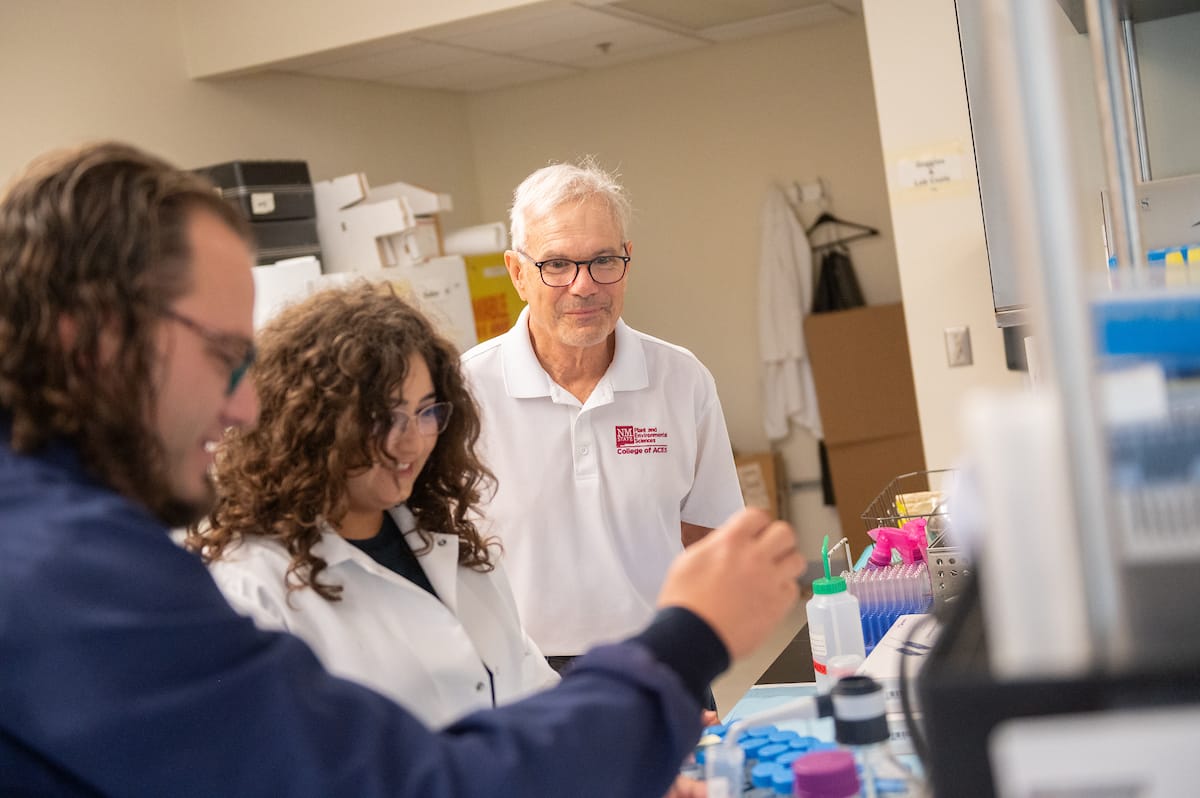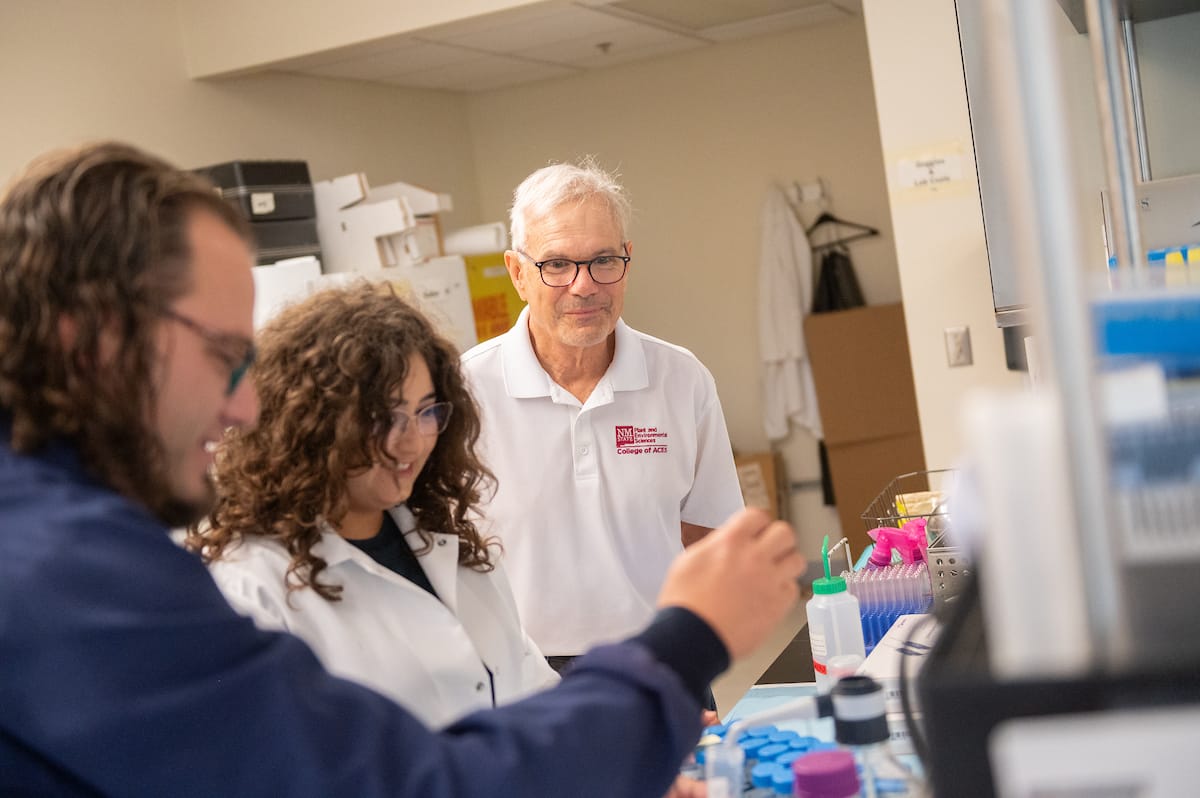NMSU research explores brackish water for agriculture amid drought concerns
Study highlights potential for salt-tolerant crops and innovative irrigation solutions using New Mexico’s vast brackish groundwater resources

Tiffany Acosta, New Mexico State University
LAS CRUCES - As the effects of long-term drought raise concern for New Mexico’s agricultural producers, one New Mexico State University researcher has taken a deep dive into an underleveraged resource that could have profound changes in the industry.
With an estimated 600 billion to 1.2 trillion cubic meters of brackish groundwater thought to be available in New Mexico, a sustainable use of this natural resource would help save freshwater supplies. Geno Picchioni, plant and environmental sciences professor emeritus in the College of Agricultural, Consumer and Environmental Sciences, has lofty aspirations for brackish water, which is more saline than fresh water but less saline than true marine environments.
“Use of brackish water on salt-tolerant crops is an important addition to drought contingency planning,” he said. “The scientific part is fascinating enough, but the potential real-world significance might be even more alluring when agriculture in New Mexico increases its reliance on saline groundwater. Significant savings in annual desalination costs could be realized if we can become more flexible about crop selection while using water that may be saltier than we are accustomed to.”
Picchioni’s research team, which included Alba Lucker, a former graduate student, and Jonathan Consford, a former undergraduate student, conducted a pair of experiments on salt-tolerant halophytes and published their findings in the journal Agricultural Water Management. The study was supported by an U.S. Department of Agriculture National Institute of Food and Agriculture’s Agriculture and Food Research Initiative grant.

The team conducted two six-week experiments on four-wing saltbush and quail bush. They irrigated with moderately saline brackish groundwater and the highly saline reverse-osmosis concentrate from the U.S. Bureau of Reclamation Brackish Groundwater National Desalination Research Facility in Alamogordo, New Mexico.
“We found that if you irrigate a heavy-hitting halophyte with high salinity, they are going to use the salt as a beneficial resource and their growth will be stimulated,” Picchioni said. “By contrast, most crops are salt-intolerant and will show significant growth and yield losses in response to high salinity.”
He continued, “Brine disposal is one of the biggest costs of desalination, so if we can put it to beneficial use and help the environment because of the saline intrusion risks, it’s a win-win all the way around.”
While some of the biggest crops in the state aren’t very salt tolerant in their current genetic form, Picchioni believes there’s potential for more salt-tolerant crops like cotton, barley, sugar beets, pistachio and asparagus, especially as the state begins to increase its dependence on brackish water sources.
Picchioni’s team also compared the effects of salt stress and salt shock on salt-sensitive leaf lettuce and salt-tolerant Swiss chard. They used 6-week-old seedlings and compared 15-day treatments of a non-saline control, a sodium chloride lab solution and calcium sulfate-dominated brackish groundwater reverse-osmosis concentrate.
“Both lettuce and Swiss chard will respond to brackish water in a way that boosts their nutritional value,” Picchioni said. “If you time brackish water toward the finishing stage, it may be particularly useful in improving nutritional value.”
The team found similarly positive results using the sodium chloride and calcium sulfate brackish groundwater sources, which may help expand the available field of brackish groundwater for successfully irrigating crops.
“If you took a snapshot of the groundwaters holding salt in the U.S.,” Picchioni said, “the majority would not be sodium chloride, which is the standard for salt-tolerance research. It may actually be calcium sulfate, which is really interesting.”
An NMSU faculty member since 1996, Picchioni has studied plant salinity stress for more than four decades. He is one of about 200 faculty members engaged in water research at NMSU.
“We are fortunate to have exceptional professors and researchers addressing unique problems associated with water resources in New Mexico,” interim Provost Lakshmi Reddi said. “Water research encompasses diverse areas such as agriculture, produced water, water management, and water treatment and remediation.”
Picchioni believes a broad interdisciplinary team of NMSU researchers and industry partners could create novel solutions with brackish water irrigation to address drought issues facing the state. He said he would like to see more emphasis on developing crop varieties that can take up salt and use it as a beneficial resource like their halophyte counterparts rather than reject it and fall victim to dehydration.
“Faster progress in that direction would be really exciting for the future,” he said.
A version of this story was originally published in the fall 2024 issue of ACES Magazine. For more stories, visit https://nmsu.news/aces-magazine-fall-2024.
Tiffany Acosta writes for New Mexico State University Marketing and Communications and can be reached at 575-646-3929, or by email at tfrank@nmsu.edu.



